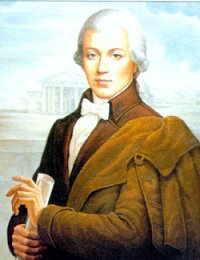Laurynas Gucevičius
Laurynas Gucevičius (also: Laurynas Stuoka-Gucevičius , Polish : Wawrzyniec Gucewicz , * 1753 in Migonys near Kupiškis ; † December 10, 1798 in Vilnius ) was an architect at the time of the Polish-Lithuanian Real Union , who is considered the first Lithuanian architect by the Lithuanians and who is the most famous representative of Lithuanian classicism .
life and work

Gucevičius first went to the Piarist school in Kupiškis and Palėvenė, and later in Panevėžys . His father was the farmer Simonas Masiulis , his mother's name was Kotryna Žekonytė . Because of his stepfather, Stuoka , he is sometimes called Stuoka-Gucevičius . The name Gucevičius (Gucewicz) possibly goes back to his godmother Anna Gucewicz née Baltušytė, who financed his education.
After school Laurynas Gucevičius came to Vilnius as a monk missionary . 1773–1775 he studied at the University of Vilnius , 1776–1777 in Rome . In 1778 he traveled through the countries of Western Europe , attended architecture lectures and learned from the works of the best architects of the time. After returning to Vilnius, he became the architect of the Verkiai Palace ensemble of the Polish nobleman and Bishop Massalski . 1789–1794 he taught cartography and military engineering at Vilnius University. In 1793 he succeeded Martin Knackfuss as professor and taught architecture.
Laurynas Gucevičius took an active part in the Kościuszko uprising of 1794. He organized and led a vigilante group in Vilnius. He was seriously injured in the battle of Ašmena . The participation in the uprising led to his temporary dismissal as professor, only in 1797 he returned as head of the architecture department.
Its most notable buildings are the Vilnius City Hall (built in 1799), the Vilnius Cathedral (1801), the Verkiai Palace ensemble , the Rokiškis Palace and the restoration of the Raudonė Castle . He made a topographic map for the western part of Vilnius . It is believed that Gucevičius worked out various projects for the important noble families, Radvila (Radziwiłł) , Sapiega (Sapieha) , Pac , Tyzenhauz and others. Characteristic of his style are the monumentality of the forms and spaces, the harmonious embedding in the surroundings as well as the special treatment and further development of the ancient architectural forms. His work became decisive for numerous architects of the classicist epoch in Lithuania and Poland .
The life and creations of Gucevičius inspired the Lithuanian poet Justinas Marcinkevičius for his vocal drama The Cathedral .
literature
- Alfredas Bumblauskas: Senosios Lietuvos istorija 1009-1795 . Paknys, Vilnius 2005, ISBN 9986-830-89-3
- Rasa Butvilaitė (Ed.): Laurynas Gucevicius ir jo epocha . Vilniaus Dailes Akad. Leidykla, Vilnius 2004. (lit., Russian, English summaries)
| personal data | |
|---|---|
| SURNAME | Gucevičius, Laurynas |
| ALTERNATIVE NAMES | Gucewicz, Wawrzyniec |
| BRIEF DESCRIPTION | Lithuanian architect of classicism |
| DATE OF BIRTH | 1753 |
| PLACE OF BIRTH | Migonys at Kupiškis |
| DATE OF DEATH | December 10, 1798 |
| Place of death | Vilnius |
